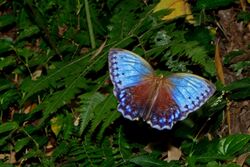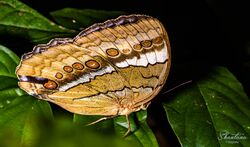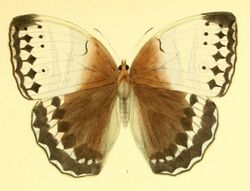Biology:Stichophthalma camadeva
| Northern jungle queen | |
|---|---|

| |
| Ventral view | |

| |
| Dorsal view | |
| Scientific classification | |
| Domain: | Eukaryota |
| Kingdom: | Animalia |
| Phylum: | Arthropoda |
| Class: | Insecta |
| Order: | Lepidoptera |
| Family: | Nymphalidae |
| Genus: | Stichophthalma |
| Species: | S. camadeva
|
| Binomial name | |
| Stichophthalma camadeva (Westwood, 1848)
| |
Stichophthalma camadeva, the northern jungle queen,[1] is a butterfly found in South Asia that belongs to the Morphinae subfamily of the brush-footed butterflies family.
Distribution
The northern jungle queen ranges from Sikkim, north Bengal, Assam, Manipur, and Nagaland in India . It is also found in the Arakan hills and northern part of Myanmar.[1][2] It is also found in Thailand
Status
Evans reports the butterfly as not rare in Sikkim and Assam and as very rare in the Naga Hills.[2] Haribal reports the butterfly as rare in Sikkim.[3]
Description
Upperside of males and female: forewing with basal third chocolate brown, shading into pale bluish white on the rest of the wing; a broad, irregular, pure white discal bar bounded on each side by sinuous pale blue lines; a series of two or three large postdiscal brownish spots, succeeded by a series of quadrate dark brown spots touching an outer series of broad lunules of the same colour; finally a subterminal row of narrow whitish crescentic marks and a terminal dark brown line. Hindwing dark chocolate brown, paler towards base; a broad postdiscal, bluish-white, curved band formed of paired, large, inwardly angular spots in the interspaces followed by a continuous series of broad brown lunules, a subterminal row of narrow crescentic white marks, and a terminal brown hue. Underside ochraceous, irrorated (sprinkled) with greenish scales on the basal area of the wings and on the discal bar of the hindwing; forewings and hindwings crossed by subbasal and discal, transverse, sinuous, dark brown lines, followed by a straw-coloured discal bar, a brownish diffuse band, very dark ochraceous series of partly ocelli and partly obscure spots, and a postdiscal outer, broad, diffuse dark brown band, ending posteriorly in a black spot at the tornus of the hindwing. Antennae, head, thorax and abdomen chocolate brown.[4]
See also
- List of butterflies of India
- List of butterflies of India (Morphinae)
- List of butterflies of India (Nymphalidae)
Cited references
- ↑ 1.0 1.1 "Stichophthalma C. & R. Felder, 1862" at Markku Savela's Lepidoptera and Some Other Life Forms
- ↑ 2.0 2.1 Evans, W.H. (1932). The Identification of Indian Butterflies (2nd ed.). Mumbai, India: Bombay Natural History Society. pp. 132–133.
- ↑ Haribal, Meena (1992). The Butterflies of Sikkim Himalaya and Their Natural History. Gangtok, Sikkim, India: Sikkim Nature Conservation Foundation. p. 128.
- ↑ Bingham, C.T. (1905). The Fauna of British India, Including Ceylon and Burma Butterflies. 1 (1st ed.). London: Taylor and Francis, Ltd..
References
- Wynter-Blyth, Mark Alexander (1957). Butterflies of the Indian Region. Bombay, India: Bombay Natural History Society. ISBN 978-8170192329. https://books.google.com/books?id=yEkgAQAAMAAJ.
Wikidata ☰ Q7616176 entry
 |



